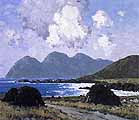On arriving by train to Achill Sound, the Henrys travelled by horse-drawn carriage to Dugort. However, largely as a result of the Rev. Nangle's Protestant Mission, Dugort at this time was the centre of Achill's tourism industry. Paul Henry noted that 'every second house seemed to be an hotel or boarding house'. The Henrys travelled across the island to the village of Keel where they took lodgings with John and Eliza Barrett, who ran the Post Office. His hosts, who did not usually take in boarders, were to extend 'infinite and ungrudging hospitality' to Paul Henry. He was to commemorate the Barretts in a painting, 'My Host and Hostess' (1910-1913), displayed in the Ulster Museum in Belfast.
For Paul Henry Achill Island was love at first sight and he instantly decided to remain on the island, allegedly tearing up his return rail ticket and scattering the fragments into the sea. As he later wrote in his autobiography:
..."As I wandered round and through the village [Keel], and out on the road that led to Pollough, and looked down on Dooagh and to the noble cliffs of Achill Head, I felt that here I must stay somehow or another. I would not go any further".
(quoted in S.B. Kennedy, p41)
The first fruits of Paul Henry's prolonged visit to Achill came with an exhibition in Belfast in 1911. Titled 'Paintings of Irish Life', it was a joint exhibition with his wife Grace. Reviewing it, the newspaper The Northern Whig said that the Henrys had 'flung away the accepted formulas as boldly as Synge did when he began to do in drama what they have set themselves to do in colour. The reference to J.M. Synge is one that was to recur during Paul Henry's lifetime, and the links between the two men's works were often rendered explicit in Paul Henry's paintings. The Northern Whig compared his work 'A Prayer for the Departed' (1910-1911, Ulster Museum, Belfast) with 'the grimness and something of the dignity of the closing scene in "Riders to the Sea".' Later in 1911, after being elected to the Ulster Arts Club, Paul Henry exhibited 'The Watcher', a picture of a peasant girl standing on rocks looking out anxiously to a stormy sea. The allusions to Riders to the Sea were made literal when Paul Henry added to the title of the picture a short passage from the play, Maurya's lament over her son's death. In 1912 an exhibition of the Henrys' work in London wad titled 'Paintings of Co. Mayo, Ireland (Synge's Country) by Mr and Mrs Paul Henry'.
Paul (and Grace) Henry's post-impressionist credentials were confirmed by the reception given to the Belfast exhibition. The Northern Whig commented:
"... You will look through this exhibition in vain for the 'sweetly pretty' Ireland of the popular illustrators, for the chocolate-box colleen or the cardriver with his budget of comic stories. In place of the glamour of false romance you get the veracity of the thing seen; sentimentalism gives way to stark sincerity".
(quoted in S.B. Kennedy, p45)
In 1912 Paul and Grace Henry had their first exhibition in Dublin, with Paul contributing 39 works to a show that included works by George Russell ('Æ') and Frances Baker. The Dublin critics were not impressed with the work of either of the Henrys, criticising them for being influenced by French post-Impressionism.


